Architecturally, the notion of libraries resting on pillars is as commonplace as the idea of concrete lions lining their front staircases.
Philosophically, not so much.
But when Jon E. Cawthorne, the current dean of the University Library System, including the School of Information Sciences at Wayne State, mentions his plan to set the five libraries that he oversees on pillars, he’s talking about a singular vision that transcends bricks and beams — and, for that matter, even books.
More than just a collection of tomes and journals, the system that Cawthorne envisions is equal parts information hub, research lab and community interface, an organic workshop where outside- the-box ideas can marry high-minded ideals about research, diversity, social justice, community engagement and educational equity.
And undergirding it all, says Cawthorne, are his four key pillars for the library system’s growth and evolution: student success, scholarship, culture and people, and community engagement.
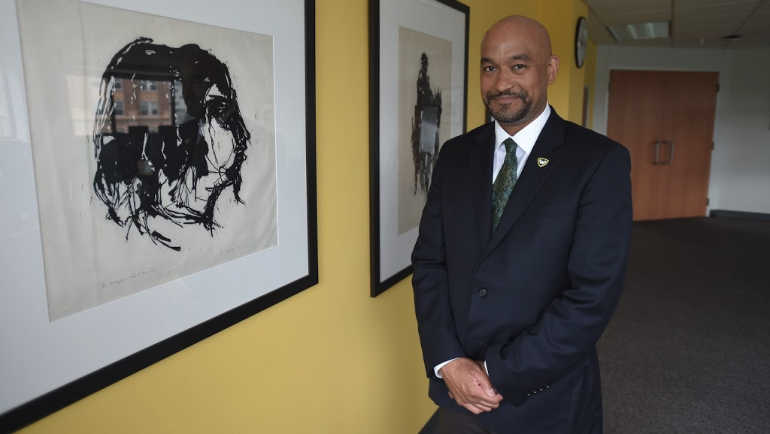
“The pillars say this is the way that we’re going to work,” he says during a recent conversation in his office at the David Adamany Undergraduate Library. “Each one of these pillars is very important to define this new way that libraries might work and benefit the campus.”
As librarians go, Cawthorne may not see himself as a maverick, but he regards his distinction as one of the few African American leaders in the information sciences as a calling as much as an accomplishment. Of the men and women who head the 126 research library systems that are part of the Association of Research Libraries — “the biggest and baddest research libraries in the world,” boasts Cawthorne — the WSU dean is one of only three or four blacks in the position.
And he means to make it count.
Responsible for oversight of the School of Information Sciences and WSU’s five libraries (the Shiffman Medical Library, the Arthur Neef Law Library, and the Purdy/Kresge, Walter P. Reuther and Undergraduate libraries), Cawthorne doesn’t just want to transform how the campus and the surrounding Detroit communities access information at the five institutions, but how they understand that data and, ultimately, how they leverage it.
Collaborating with the community
Of the four “visionary pillars” he mentions, the community engagement mission, he says, is the one that has been established the fastest since his arrival at Wayne State in August 2017.
“We’re addressing that pillar of community engagement right now,” says Cawthorne, who has opened up conference rooms and other spaces within the libraries to community meetings, student organization gatherings and other events. “We’re putting people together. We’re putting out the kinds of ideas that interest people. Community engagement activity will continue to increase.”
Cawthorne admits that the definition of “community engagement” is often an amorphous one that can assume as many shapes as there are engagement efforts. But in his mind, engagement is nothing if not a symbiotic bond that ensures that both campus and community prosper and feed one another.
“Some programs might send a dance team to dance before the Pistons and call that community engagement,” says Cawthorne. “That’s fine, but what I’m talking about are the ways that we do it to help benefit the students and the community. We are an institution that cares about being in Detroit and being an economic engine of Detroit — so we must be super aware of the issues. And that means providing more places where the community can be heard — and where we can listen.”
To that end, he has been diligent about opening up more of the library spaces, especially for non-traditional events by local organizations and community projects, as a way to promote the library system as a welcome haven to the city beyond the campus. For example, the Undergraduate Library was host last year to the 2018 DHack, a raucous gathering where scores of local college and high school tech wizards descended on the WSU campus to collaborate on software and hardware projects. Sure, the event was loud and clashed with the stereotype of libraries as stone-silent sepulchers, but it also created a citywide buzz and further reinforced Cawthorne’s notion that libraries can be so much more.
“If we are an institution that cares about being in Detroit and being an economic engine of Detroit,” he says, “then we must be super present of what the issues are. Right now we’re in that pillar of community engagement. We’re putting the people together, and we’re putting on the kinds of things that will draw people.”
To accomplish some of this, Cawthorne has even moved slews of books out of some library spaces. “As a university, of course we have a population that almost has to come to us for study and research, but we want to make sure we’re providing the space and tools they really need,” he says. “At our Undergraduate Library, we’ve taken a lot of books out. Why? Because we saw people were coming in groups to do group work, not just look up books. So we wanted to have a lot of space for that to happen. They can still find the books, of course, but they’ve also got the space they need to operate.”
Agent for change
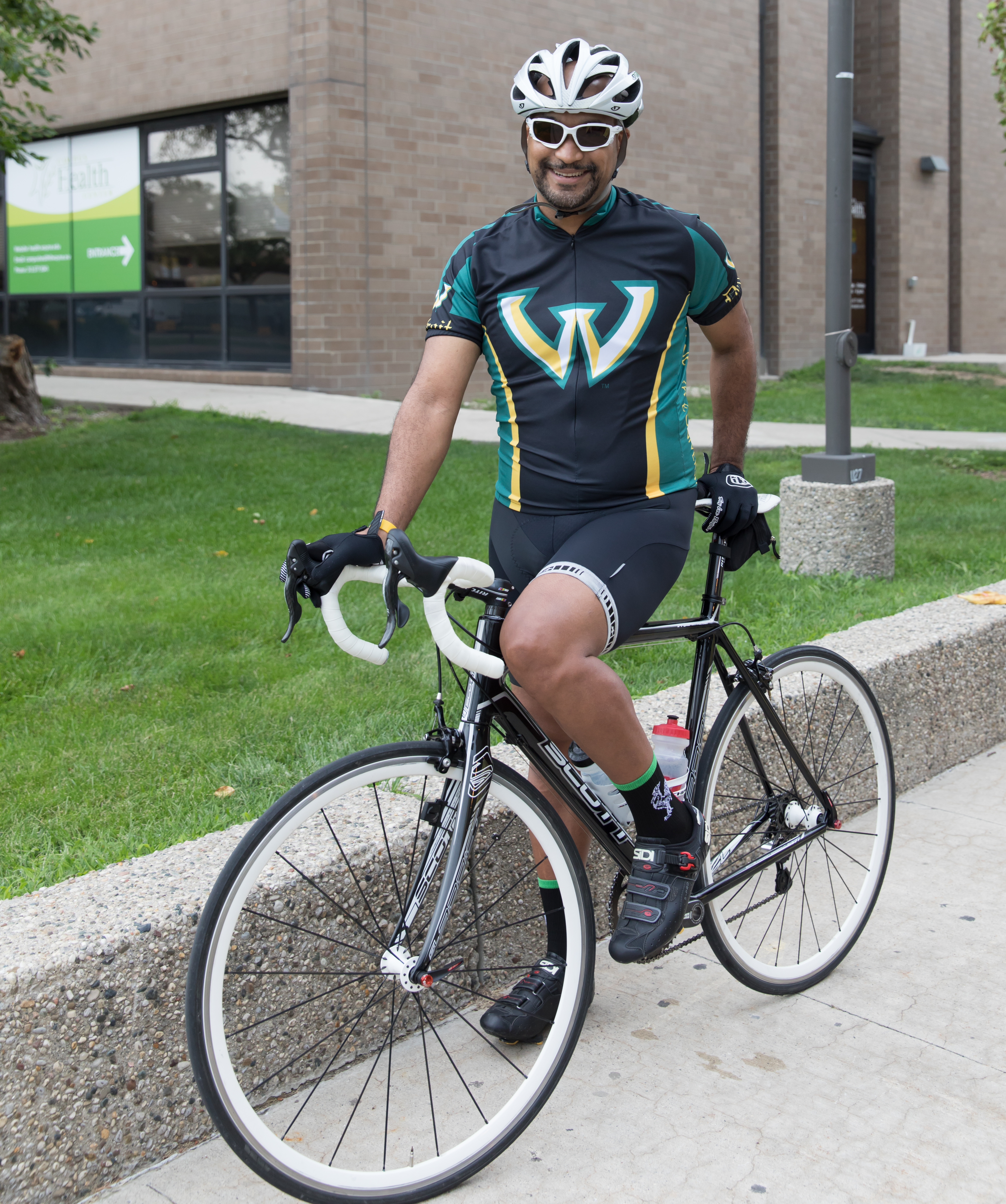
Improving engagement also means growing the organization and re- shaping the culture of the WSU library system, another of the foundational ideas upon which Cawthorne’s vision rests. Cawthorne says the library system recently initiated a cultural assessment survey similar to a university-wide “climate survey.”
“Because we did it for the first time, I thought we might have maybe 30 people take it,” recalls Cawthorne. “We have 270 people who work in the library. We had 190 people take that assessment about how they feel, how the library is organized, who makes decisions, how you come to projects. These are all very important things, and if we want to have people just as excited as I am or you are working in the library, they need to be able to talk about the ideas that they have.”
To encourage such exchanges, the library system began to have meetings where staffers are encouraged to share unorthodox ideas. Cawthorne, whose School of Information Sciences also has 12 faculty members, says that the meetings have yielded ideas such as creating rooftop gardens on library buildings, WSU-driven research journals and even a seed library that would house assorted vital seeds to grow plants in case of emergency.
While the project likely won’t develop in the near future, Cawthorne views the mere act of offering up such radical ideas as representing the kind of transformational thinking he wants to nurture at Wayne State.
Of course, Cawthorne has always seemed fine with embracing change, even before he came to work at Wayne State. A former hoops star, the Portland, Oregon, native says he turned down a basketball scholarship to focus fully on academics. He also switched sports and became an avid cyclist; he can often be seen riding with President M. Roy Wilson at WSU-sponsored cycling events such as the Baroudeur and the Road Warrior cycling tour. He has lived on both coasts and is on his second stint in Detroit after serving as head of the Detroit Public Library’s main library from 1999 to 2002.
And he doesn’t want change merely for its own sake. In the age of social media and Wikipedia, Cawthorne is well aware of how ever-widening access to oceans of online data has re-shaped many people’s views of — and perceived need for — traditional brick-and-mortar libraries. According to estimates, between Google, Amazon, Microsoft and Facebook alone, the total amount of information stored is about 1.2 million terabytes. Put another way, if all current stored data were divided up among the global population today, every living person would get more than 300 times the amount of information stored in the legendary Library of Alexandria.
Even so, says Cawthorne, the internet doesn’t even come close to capturing the breadth of human knowledge: “There’s a perception that information is all on the internet. It’s actually just the opposite. If my hand were all of human knowledge, really what’s on the internet is your thumbnail.”
The deeper dive
Furthermore, says Cawthorne, much of that information is shallow and doesn’t encourage deeper, more nuanced research.
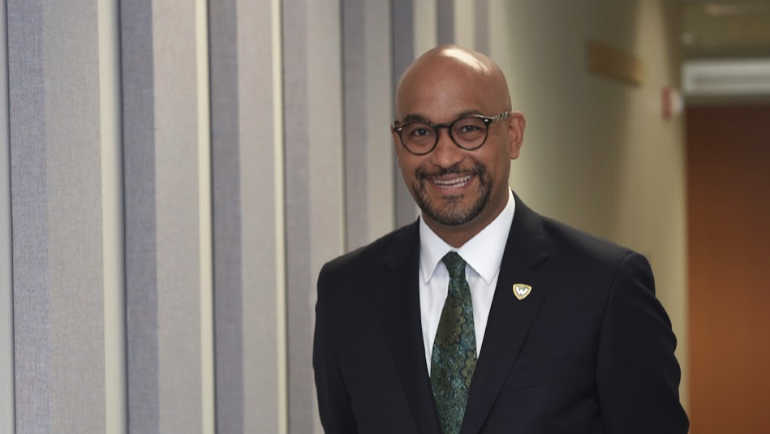
“Facebook, Google, all those are great, but people are mistaken if they think that means they don’t need libraries or that they’re getting all of the information online that they need,” he says. “These digital properties are just really surface. When we talk about archives, when we talk about personal papers, when we talk about libraries, when we talk about these things, we’re talking about the amount of information in totality. And it’s a lot.”
And information isn’t static, Cawthorne reminds. “For example, we are working with the School of Medicine to help them think about how information sciences intersect with medicine. One doctor over there told me that, in his field, medical information is going to double every 73 days in the year 2020. How many years do doctors train in schools of medicine to then go become doctors? And then a portion of that information is going to change every 73 days? How much information is that? These professions need quality research institutions, quality libraries, not just Google.”
That said, libraries and librarians alike have to rethink themselves, says Cawthorne.
“Our profession is very passive,” he says. “We’re set up for people to come in and ask us a question. But really, librarians are researchers and people who facilitate research. Search engines can’t do what we can. That’s why I tell people that the things that happen at the front desk of the library — where people are served — those things are really necessary. The problem is, people aren’t coming to the desk like they should because they think the information is all on the internet.
So the desk has to find a way to go to them.”
And that means re-training current librarians and teaching aspiring information professionals new ways of approaching the profession.
“Librarians have great opportunities to connect with people and to show them what we can do as a profession,” he says. “The library is the only interdisciplinary place on the campus, if you think about it. Everybody else has majors, minors, and all the students have to go get their majors and minors. But in the future, what’s going to be really beneficial for the students is an ability to be able to think across those majors. An engineer needs to understand about humanities. We must create an opportunity for them to think in an interdisciplinary way.”
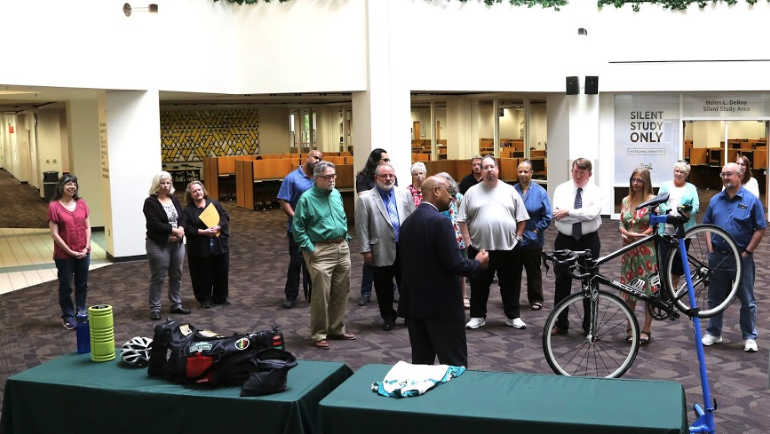
Full scholarship
Cultivating greater scholarship, another of Cawthorne’s philosophical pillars, also means working closer with faculty to better spotlight members’ work and achievements, he says. He dreams of a day, for instance, when the university can publish more faculty research rather than have professors give their findings to research journals that the university then turns around and purchases.
“We hire faculty to do research to get promoted and get tenured,” Cawthorne says. “They do that research for free, and they send that research over to journals that are reputational in their fields. And they get published in those journals and get tenured based on that. Then those vendors turn around and sell that research back to institutions. We can’t actually share our research far and wide on the campus because we have these agreements to just buy this research back. The companies have put these inflationary increases in place in the last 25 years. So what it used to cost to buy these journals and what it costs now is just unsustainable for higher education and for the lack of libraries.
“But what it’s made me do is think about where does scholarship live? How can we work differently to educate our faculty to think about where scholarship lives? Because if we can have it in open access, that means the whole world can have access to the research that is done at Wayne State.”
Under the present system, though, universities pay a high price for that research. The WSU libraries’ collection budget is about $9 million, he says, smaller than some other state institutions but nonetheless a considerable sum to lay out for published works. All told, he figures, the 126 research libraries in North America pay upward of $5 billion for these published works.
“These companies have monetized the actual work, and because the faculty want to be in those journals so much, they sign away their copyright,” says Cawthorne. “So now it’s these journals that own that stuff and we’re paying for it. How do we deal with this?”
Cawthorne says he has some ideas, not the least of which is the concept of providing researchers with the tools to publish themselves through the University Library System. He envisions them using open-access journal publishing software and has been talking with President Wilson as well as certain charitable foundations about providing the resources to move his self- publishing vision to reality.
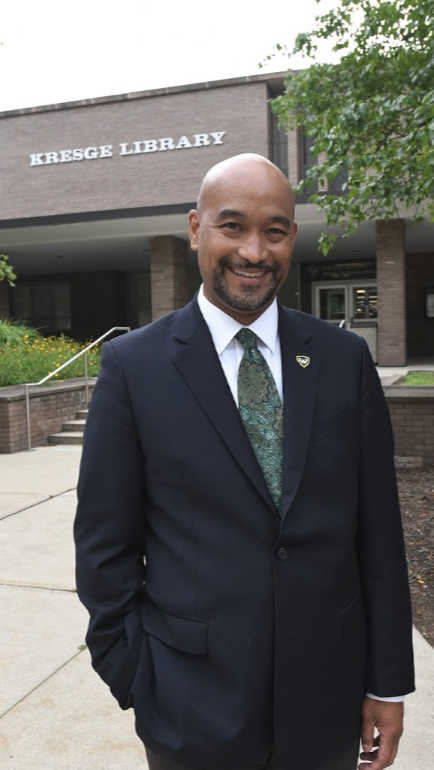
“President Wilson has a very large vision of positioning Wayne State as a top institution of higher education around the world,” he says. “When you think about how universities are ranked as education institutions, when you look at the metric, four of those metrics are about citations. So if you were to create journals that were cited more, you’d raise those metrics.
“Moreover, of the 70,000 journals that we have, all of them are very narrow in scope. You have heart journals, anthropology journals, math journals — and the faculty in each one of these departments all want to publish in those journals. But very few in existence are interdisciplinary. That could be a place where the library can come in and be a place where interdisciplinary journals get created and get support. It’s not like we won’t ever have to deal with vendors. We will. But it’s still about change.”
Cawthorne says the scholarship issue goes to the very heart of the fundamental considerations libraries must make as they reconfigure themselves.
“We are working as fast as we can to say what is a library, and what does our work mean in that context. As part of that, we are going to have conversations about what it means to publish digitally in the library.”
As critical as working with faculty, of course, is the libraries’ ability to empower and help educate the student body. With student success as his fourth pillar, Cawthorne points out that he and his team have worked closely with several academic success units to realize this portion of his vision.
“We’ve worked with Warrior VIP and the APEX Scholars,” he says, naming two of the university’s most successful academic services programs. “And the charge to our team is to really think about what we can go and offer. As I mentioned, as librarians, we wait for people to come ask us questions. But can we go to an APEX Scholar meeting or can we go to Warrior VIP and talk with the counselors? Can we listen to what they might need so that two years from now we can actually figure out if our work led to student success and retention?”
But for all the ways he hopes to do things differently, for all of the change he has dreamed of and actually initiated, Cawthorne says his vision ultimately revolves around what he has always seen as the central role of libraries, both before and after the dawn of the digitally driven Information Age.
“Things change, but in some ways, whether we are more aggressive about our research role or our place in the community, the library is still the space that is has always been,” says Cawthorne. “The library is a place for ideas.”
This story originally appeared in the Fall 2019 issue of Warriors magazine.